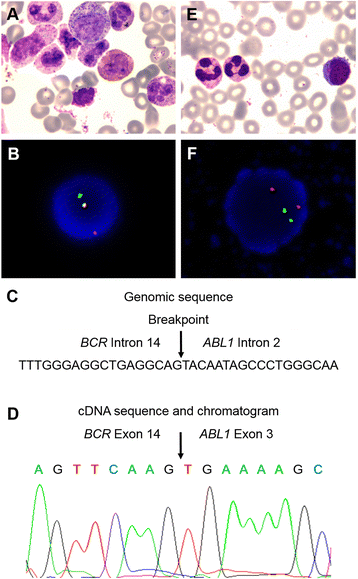A novel BCR-ABL1 fusion gene with genetic heterogeneity indicates a good prognosis in a chronic myeloid leukemia case
- PMID: 28533818
- PMCID: PMC5438485
- DOI: 10.1186/s13039-017-0322-8
A novel BCR-ABL1 fusion gene with genetic heterogeneity indicates a good prognosis in a chronic myeloid leukemia case
Abstract
Background: Chronic myelogenous leukemia (CML) is a pluripotent hematopoietic stem cell disorder caused by the fusion of the BCR and ABL1 genes. Quantitative RT-PCR (qRT-PCR) is a routinely performed screening technique to identify BCR-ABL1 fusion genes, but a limitation of this method is its inability to recognize novel fusions that have not been previously characterized. Next-generation sequencing (NGS) is an effective and sensitive detection method for the determination of novel BCR-ABL1 fusion genes as well as previously characterized ones. The oncoprotein tyrosine kinase BCR-ABL1 is a constitutively active kinase involved in the activation of a number of signaling pathways, and it has been the therapeutic target for tyrosine kinase inhibitors (TKIs) such as imatinib. Reports have presented opposing viewpoints about the effect of the disrupted Src homology 3 (SH3) domain on TKI efficacy.
Findings: We here report that using NGS we identified a novel BCR-ABL1 fusion gene with breakpoints in the BCR intron 14 and the ABL1 intron 2, leading to partial deletion of its SH3 domain. In the present case, the patient received targeted therapy with the TKI imatinib at 400 mg/day and no adverse reaction was reported. The patient eventually entered remission with decreased proliferation of karyocytes and granulocytes. We also identified mutations in genes, including TP53, FLT3, ASXL1, SETBP1, CEBPA and CBL, that seemed to have an influence on the outcome of TKI therapy targeting the BCR-ABL1 protein.
Conclusions: Together with previously reported results, it is clear that the genetic heterogeneity of CML patients significantly affects the presentation of the disease and its progression and therefore should inform the design of the therapeutic strategy.
Keywords: BCR-ABL1; CML; Genetic heterogeneity; NGS; SH3 domain.
Figures

Similar articles
-
A novel BCR-ABL1 fusion gene identified by next-generation sequencing in chronic myeloid leukemia.Mol Cytogenet. 2016 Jun 27;9:47. doi: 10.1186/s13039-016-0257-5. eCollection 2016. Mol Cytogenet. 2016. PMID: 27350795 Free PMC article.
-
Novel BCR-ABL1 fusion and leukemic mutations of SETBP1, PAX5, and TP53 detected by next generation sequencing in chronic myeloid leukemia.Cancer Biol Ther. 2016 Oct 2;17(10):1003-1009. doi: 10.1080/15384047.2016.1219821. Epub 2016 Sep 10. Cancer Biol Ther. 2016. PMID: 27611742 Free PMC article.
-
Detection of BCR-ABL1 kinase domain mutations causing imatinib resistance in chronic myelogenous leukemia.Methods Mol Biol. 2013;999:25-39. doi: 10.1007/978-1-62703-357-2_2. Methods Mol Biol. 2013. PMID: 23666688
-
New Developments in Chronic Myeloid Leukemia: Implications for Therapy.Iran J Cancer Prev. 2016 Feb 22;9(1):e3961. doi: 10.17795/ijcp-3961. eCollection 2016 Feb. Iran J Cancer Prev. 2016. PMID: 27366312 Free PMC article. Review.
-
Mutations in the BCR-ABL1 Kinase Domain and Elsewhere in Chronic Myeloid Leukemia.Clin Lymphoma Myeloma Leuk. 2015 Jun;15 Suppl:S120-8. doi: 10.1016/j.clml.2015.02.035. Clin Lymphoma Myeloma Leuk. 2015. PMID: 26297264 Review.
Cited by
-
Philadelphia Translocation in MDS: A Case Report and a Brief Review of the Literature Looking at Its Prevalence, Disease Progression, and Treatment Options.Case Rep Hematol. 2018 Nov 22;2018:5865321. doi: 10.1155/2018/5865321. eCollection 2018. Case Rep Hematol. 2018. PMID: 30595928 Free PMC article.
-
Hsa-miR-181a-5p, hsa-miR-182-5p, and hsa-miR-26a-5p as potential biomarkers for BCR-ABL1 among adult chronic myeloid leukemia treated with tyrosine kinase inhibitors at the molecular response.BMC Cancer. 2022 Mar 26;22(1):332. doi: 10.1186/s12885-022-09396-5. BMC Cancer. 2022. PMID: 35346116 Free PMC article.
References
-
- Melo JV. The diversity of BCR-ABL fusion proteins and their relationship to leukemia phenotype. Blood. 1996;88(7):2375–84. - PubMed
LinkOut - more resources
Full Text Sources
Other Literature Sources
Research Materials
Miscellaneous

